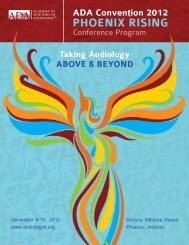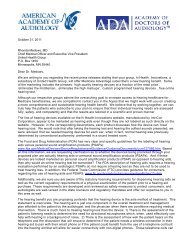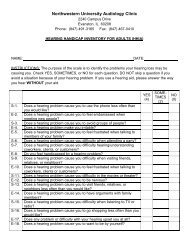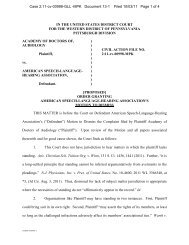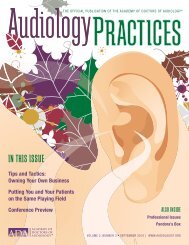IN THIS ISSUE - Academy of Dispensing Audiologists
IN THIS ISSUE - Academy of Dispensing Audiologists
IN THIS ISSUE - Academy of Dispensing Audiologists
Create successful ePaper yourself
Turn your PDF publications into a flip-book with our unique Google optimized e-Paper software.
A quick look at today’s hearing aids will show many that <strong>of</strong>fer<br />
wireless communication. As with any novel technology, companies<br />
developing new hearing aid technology clamor to find<br />
the ideal method for wireless connectivity; the various methods<br />
for wireless connectivity <strong>of</strong>fer different features, benefits,<br />
and constraints. As experts in the treatment <strong>of</strong> hearing loss<br />
through amplified listening we are charged with understanding<br />
each <strong>of</strong> these technologies, the differences among them,<br />
and making a selection that is consistent with the treatment<br />
plan they have selected for a given patient. Although there<br />
are a wide range <strong>of</strong> wireless features in hearing aids, this<br />
article aims to clarify modern techniques for wireless audio<br />
streaming from media sources (e.g. a television) or a mobile<br />
telephone.<br />
First, wireless technology in today’s hearing aids can be classified<br />
into one <strong>of</strong> three types: near-field magnetic induction<br />
(NFMI), 900 MHz, or 2.4 GHz. These three technologies span<br />
a wide wireless frequency range. NFMI uses the lowest range<br />
<strong>of</strong> frequencies and will be referred to as near-field wireless<br />
DIAGNOSIS & TREATMENT<br />
communication. The NFMI wireless signal easily passes through<br />
and around objects such as the human head, making it a favorable<br />
option for ear-to-ear signal processing. The disadvantage<br />
<strong>of</strong> NFMI is a relatively short—near-field—wireless transmission<br />
range <strong>of</strong> approximately 1 meter. For this reason, NFMI requires<br />
an intermediate relay, typically neck worn, for audio streaming at<br />
distances over 1 meter. Using an intermediate transmission frequency,<br />
900 MHz <strong>of</strong>fers both ear-to-ear communication between<br />
a pair <strong>of</strong> hearing aids and what will be referred to as far-field<br />
wireless communication. In the context <strong>of</strong> hearing aids, far-field<br />
wireless systems <strong>of</strong>fer wireless communication <strong>of</strong> approximately<br />
5 meters. Finally, at the highest transmission frequency for wireless<br />
hearing aid technology is 2.4 GHz; this high-frequency signal<br />
allows for effective far-field connectivity, again up to 5 meters,<br />
however the high-frequency nature <strong>of</strong> 2.4 GHz may constrain the<br />
robustness <strong>of</strong> ear-to-ear signal processing, as the signal does not<br />
propagate through or around obstacles with the efficiency <strong>of</strong> lower<br />
frequency signals. Galster (2010) <strong>of</strong>fers additional review <strong>of</strong> these<br />
technologies.



